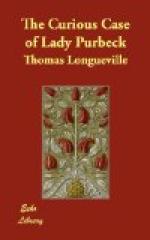If Lady Elizabeth was infuriated at the news of the match, her daughter was frenzied. She detested Sir John Villiers, and she implored her parents never again to mention the question of her marrying him. The mother and daughter were on one side and the father on the other; neither would yield an inch, and Hatton House, Holborn, became the scene of violent invective and bitter weeping.
Buckingham is said to have promised Coke that, if he would bring about the proposed marriage, he should have his offices restored to him. Buckingham’s mother, Lady Compton, also warmly supported the project. She was what would now be called “a very managing woman.” Since the death of Buckingham’s father, she had had two husbands, Sir William Rayner and Sir Thomas Compton,[13] brother to the Earl of Northampton. She was in high favour at Court, and she was created Countess of Buckingham just a year later than the time with which we are now dealing. As Buckingham favoured the match, of course the King favoured it also; and, as has been seen, Winwood, the Secretary of State, favoured it, simply because Bacon did not.
On the other side, among the active opponents of the match, were Bacon the Lord Keeper, Lord and Lady Burghley, Lord Danvers, Lord Denny, Sir Thomas and Lady Howard, and Sir Edmund and Lady Withipole.
Suddenly, to Coke’s great satisfaction, Lady Elizabeth became, as he supposed, calm and quiet. It was his habit to go to bed at nine o’clock, and to get up very early. One night he went to bed at his usual hour, under the impression that his wife was settling down nicely and resigning herself to the inevitable. While he was in his beauty-sleep, soon after ten, that excellent lady quietly left the house with her daughter, and walked some little distance to a coach, which she had engaged to be in waiting for them at an appointed place. In this coach they travelled by unfrequented and circuitous roads, until they arrived at a house near Oatlands, a place belonging to the Earl of Argyll, but rented at that time by Lady Elizabeth’s cousin, Sir Edmund Withipole. The distance from Holborn to Oatlands, as the crow flies, is about twenty miles; but, by the roundabout roads which the fugitives took in order to prevent attempts to trace them, the distance must have been considerable, and the journey, in the clumsy coach of the period, over the rutted highways and the still worse by-roads of those times, must have been long and wearisome. Oatlands is close to Weybridge, to the south-west of London, in Surrey, just over the boundary of Middlesex and about a mile to the south of the river Thames.




